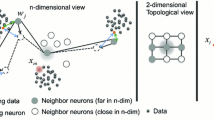Abstract
Data clustering is the fundamental data analysis method, widely used for solving problems in the field of machine learning. Numerous clustering algorithms exist, based on various theories and approaches, one of them being the well-known Kohonen’s self-organizing map (SOM). Unfortunately, after training the SOM there is no explicitly obtained information about clusters in the underlying data, so another technique for grouping SOM units has to be applied afterwards. In this paper, a contribution towards clustering of the SOM is presented, employing principles of Gravitational Law. On the first level of the proposed algorithm, SOM is trained on the input data and prototypes are extracted. On the second level, each prototype acts as a unit-mass point in a feature space, in which presence of gravitational force is simulated, exploiting information about connectivity gained on the first level. The proposed approach is capable of discovering complex cluster shapes, not only limited to the spherical ones, and is able to automatically determine the number of clusters. Experiments with synthetic and real data are conducted to show performance of the presented method in comparison with other clustering techniques.
Access this chapter
Tax calculation will be finalised at checkout
Purchases are for personal use only
Preview
Unable to display preview. Download preview PDF.
Similar content being viewed by others
References
Dunham, M.H.: Data Mining: Introductory and Advanced Topics. Prentice Hall, Englewood Cliffs (2003)
Witten, I.H., Frank, E.: Data mining: practical machine learning tools and techniques. Elsevier, Amsterdam (2005)
Kohonen, T.: Self-organizing maps. Springer, Heidelberg (2001)
Vesanto, J., Alhoniemi, E.: Clustering of the Self-Organizing Map. IEEE Trans. on Neural Networks 11(3), 586–600 (2000)
Ultsch, A.: Emergence in Self Organizing Feature Maps. In: 6th International Workshop on Self-Organizing Maps (2007)
Brugger, D., Bogdan, M., Rosenstiel, W.: Automatic Cluster Detection in Kohonen’s SOM. IEEE Trans. on Neural Networks 19(3), 442–459 (2008)
Wright, W.E.: Gravitational clustering. Pattern Recognition 9, 151–166 (1977)
Gomez, J., Dasgupta, D., Nasraoui, O.: A new gravitational clustering algorithm. In: 3rd SIAM International Conference on Data Mining (2003)
Bishop, C.M.: Pattern Recognition and Machine Learning. Springer, Heidelberg (2006)
Jenssen, R., Principe, J.C., Eltoft, T.: Cauchy-Schwarz pdf Divergence Measure for non-Parametric Clustering. In: IEEE Norway Section International Symposium on Signal Processing (2003)
Asuncion, A., Newman, D.J.: UCI Machine Learning Repository, http://www.ics.uci.edu/~mlearn/MLRepository.html
Meila, M., Heckerman, D.: An Experimental Comparison of Model-Based Clustering Methods. Machine Learning 42, 9–29 (2001)
Jenssen, R., Principe, J.C., Erdogmus, D., Eltoft, T.: The Cauchy-Schwarz Divergence and Parzen Windowing: Connections to Graph Theory and Mercer Kernels. Journal of the Franklin Institute 343(6), 614–629 (2006)
Author information
Authors and Affiliations
Editor information
Editors and Affiliations
Rights and permissions
Copyright information
© 2011 Springer-Verlag Berlin Heidelberg
About this paper
Cite this paper
Ilc, N., Dobnikar, A. (2011). Gravitational Clustering of the Self-Organizing Map. In: Dobnikar, A., Lotrič, U., Šter, B. (eds) Adaptive and Natural Computing Algorithms. ICANNGA 2011. Lecture Notes in Computer Science, vol 6594. Springer, Berlin, Heidelberg. https://doi.org/10.1007/978-3-642-20267-4_2
Download citation
DOI: https://doi.org/10.1007/978-3-642-20267-4_2
Publisher Name: Springer, Berlin, Heidelberg
Print ISBN: 978-3-642-20266-7
Online ISBN: 978-3-642-20267-4
eBook Packages: Computer ScienceComputer Science (R0)




